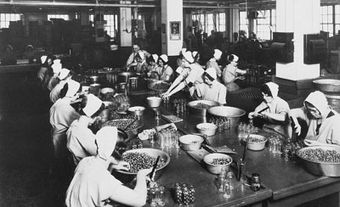
Women's International League for Peace and Freedom
The Women's International League for Peace and Freedom was founded 1915 in The Hague, the Netherlands, by women active in the Women's Suffrage movement in Europe and North America. These women wished to end WWI and seek ways to ensure that no more wars took place. The league came to Canada in the early 1920s on the initiative of socially and politically conscious women such as Dorothy Steeves and Laura Jamieson, founders of the Vancouver branch. Branches were also formed in Toronto, Edmonton and Winnipeg. In Toronto J.S. Woodsworth's wife, Lucy, was an active member.
Agnes MacPhail was probably the best-known member, serving for a number of years as honorary president. In the West, Violet McNaughton, a journalist and ardent supporter of the concerns of both women and farmers, played a key role in promoting the organization and in uniting other groups concerned with peace and Disarmament.
In Canada the league was involved in promoting peace education and conducting campaigns for disarmament and against militarism in general. The protest against cadet training in the schools was one of its most persistent campaigns. WILPF also conducted a study into school textbooks, which, members felt, glorified war and paid insufficient attention to the values of cooperation and harmony.
In 1931 the international body initiated a petition campaign for universal disarmament; 491 000 signatures were collected in Canada. Just before and during WWII, the Toronto branch worked to help Refugees settle and learn English. But the league declined during the 1940s and 1950s, in part because of renewed militarism and fear engendered by WWII and the subsequent Cold War. Only the Vancouver branch remained after the mid-1950s, but with a greatly reduced membership, and it too was dismantled.
However, in the late 1970s a branch was formed in Ottawa, and later the Vancouver branch re-emerged and membership across the country began to grow. In 1993 the Ottawa Branch published The Canadian Women's Budget, which compares the federal government's expenditures for social programs and services and the national defence budget. It proposes an alternative approach to security that requires a restructuring of government priorities and policies that reflects the need of women and that benefits all of society. The Canadian Women's Budget maintains that the best way to ensure security, both inside Canada and throughout the world, is to provide for basic human needs rather than through military expenditures.
The WILPF continues to be active in women's, peace and social justice issues. It was active in the protests against the Gulf War, and continues to collect signatures for a comprehensive test ban treaty. Through its newsletter, The WILPF News, it outlines its activities in Canada and internationally, and analyzes various social and political events in the world.
The WILPF is a member of the National Action Committee on the Status of Women (NAC) and is on the steering committee of the Canadian Peace Alliance (CPA).
See also Peace Movement.

 Share on Facebook
Share on Facebook Share on X
Share on X Share by Email
Share by Email Share on Google Classroom
Share on Google Classroom

